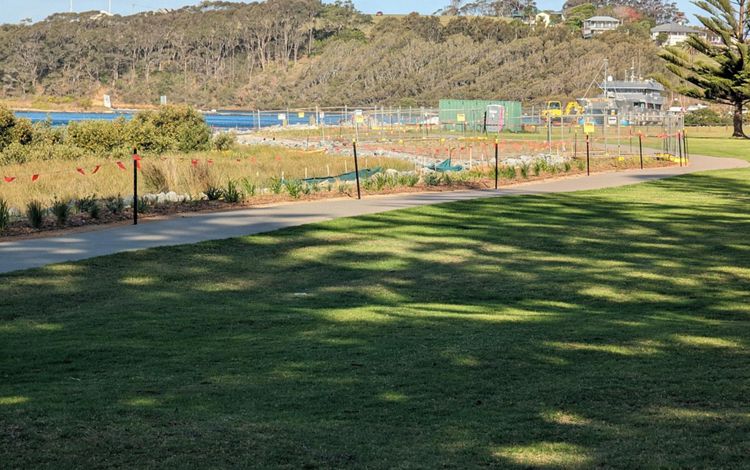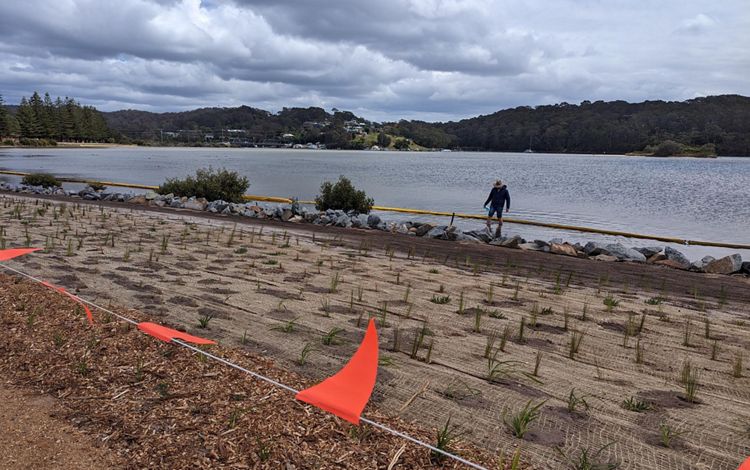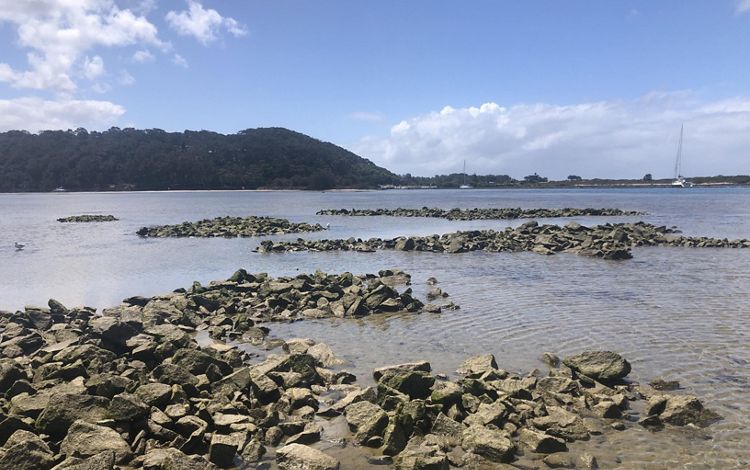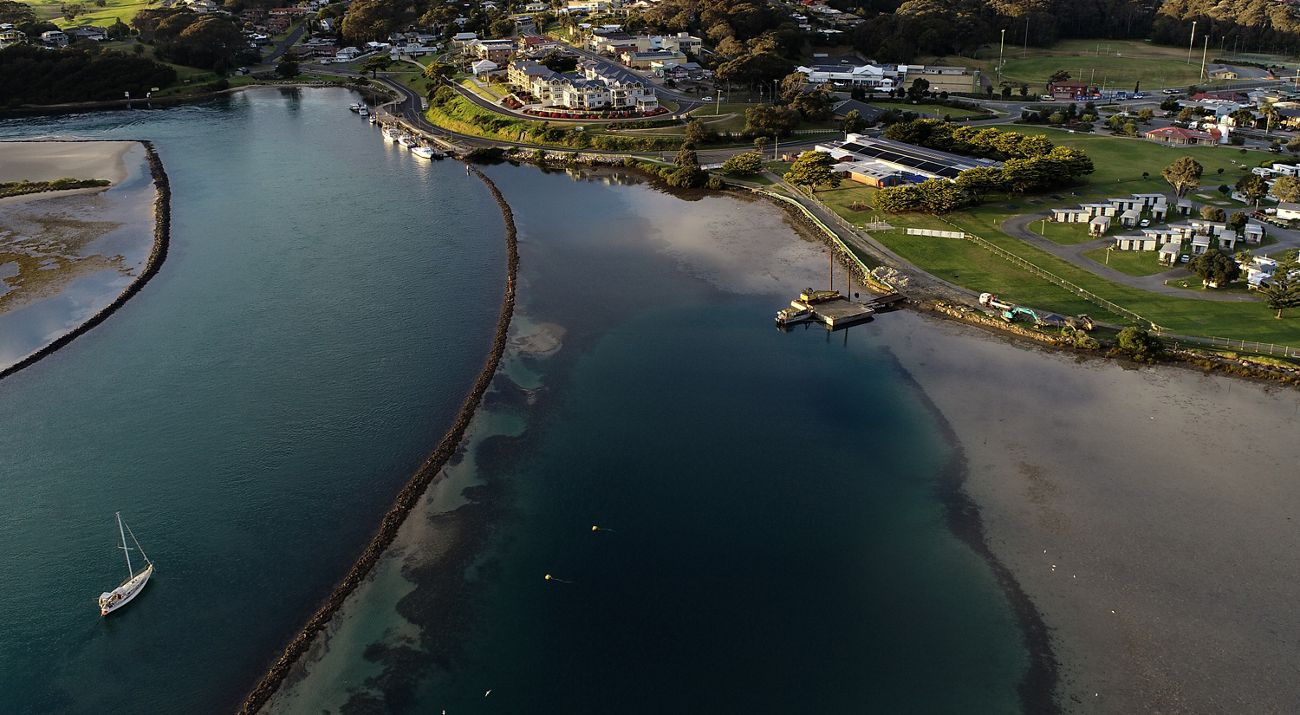First Living Shoreline project in NSW supports biodiversity and coastal protection in iconic Wagonga Inlet
Media Contacts
-
Vanessa Billy
Communications Manager
The Nature Conservancy Australia
Mobile: 0478 638 180
Email: vanessa.billy@tnc.org
The Nature Conservancy (TNC) is delighted to announce the completion of the landmark Wagonga Inlet Living Shoreline project this week, with works to remove a degraded sea wall and restore saltmarsh habitat now completed.
The project is a collaboration between The Nature Conservancy Australia, the Eurobodalla Shire Council (ESC) and NSW Department of Primary Industries (DPI) Fisheries.
The project just won an award for Innovation at the Joint Coast to Coast and NSW Coastal Conference on 2 Nov 2023, a fantastic recognition of the innovative methods and techniques the project showcases to address coastal management issues such as coastal erosion.
Wagonga Inlet Living Shoreline project



Heidi Thomson, Natural Resource and Sustainability Coordinator from ESC, said that the restoration works along a 400m section of the inlet will provide 3,000m2 of additional saltmarsh and terrestrial habitat for native shorebirds and fish, water quality improvements, climate change resilience and a simply beautiful place for the community to enjoy.
“It has been fantastic to see the community come together to support this project. We were lucky to work alongside the Wagonga Local Aboriginal Land Council Rangers and the Joonga Rangers who planted over 15,000 plants,” Ms Thomson said.
Funds for plantings were provided by the NSW Environmental Trust.
The soon-to-begin construction of the jetty and pontoon is supported by the NSW Recreational Fishing and Camping Facilities grants program.
TNC’s South East Oceans Coordinator, Kirk Dahle, said saltmarsh is a key habitat within the estuarine seascape of NSW that has been degraded through human impacts such as foreshore developments, coastal erosion and land reclamation.
“The project combines natural elements, such as saltmarsh and oyster reefs, as opposed to traditional concrete and rock seawalls,” he said.
Quote: Kirk Dahle
The project was unique, not only for the benefits it will bring to nature and people in the inlet, but also because it demonstrates the importance of nature-based solutions to coastal erosion.
The improvement of the foreshore follows the completion of the first Australian Flat Oyster reef in NSW and the first intertidal oyster reef on the NSW south coast in July last year, with contributions from the Marine Estate Management Strategy.
NSW Department of Primary Industries (DPI) Fisheries Manager, Jillian Keating, said that the restoration of oyster reefs at Wagonga Inlet will benefit both people and nature.
“By filter feeding, oysters enhance water quality, and support a variety of species including the threatened Black Rock Cod. The reefs will provide habitat for marine life, as well as an important natural defence against coastal erosion and damage from storms,” Ms Keating said.
Department of Regional NSW’s Research Scientist MEMS Dr Victoria Cole said 15 species of fish were observed on the restored Australian Flat Oyster reef two weeks ago during the underwater visual census monitoring. Additionally, Sargassum seaweed is also starting to grow.
“The diversity in species observed is similar to the diversity we find on naturally occurring Australian Flat oyster habitats in the Inlet,” Dr Cole said. “This is impressive, particularly given how early it is since the reef was established.”
Wagonga Inlet is one of 13 locations identified for reef restoration under Reef Builder, a partnership between the Australian Government and TNC to bring shellfish reefs back from the brink of extinction and support the economic recovery of communities impacted by bushfires and COVID-19 restrictions.
To find out more about Reef Builder and the Wagonga Inlet Living Shoreline project visit The Nature Conservancy Australia website and the project page.
The Nature Conservancy is a global conservation organisation dedicated to conserving the lands and waters on which all life depends. Guided by science, we focus on getting things done efficiently and with the greatest positive impact for conservation. We’re a trusted organisation working in more than 70 countries and territories around the world on innovative solutions to our world’s toughest challenges so that nature and people can thrive together. To learn more about The Nature Conservancy in Australia, follow us on Facebook.
